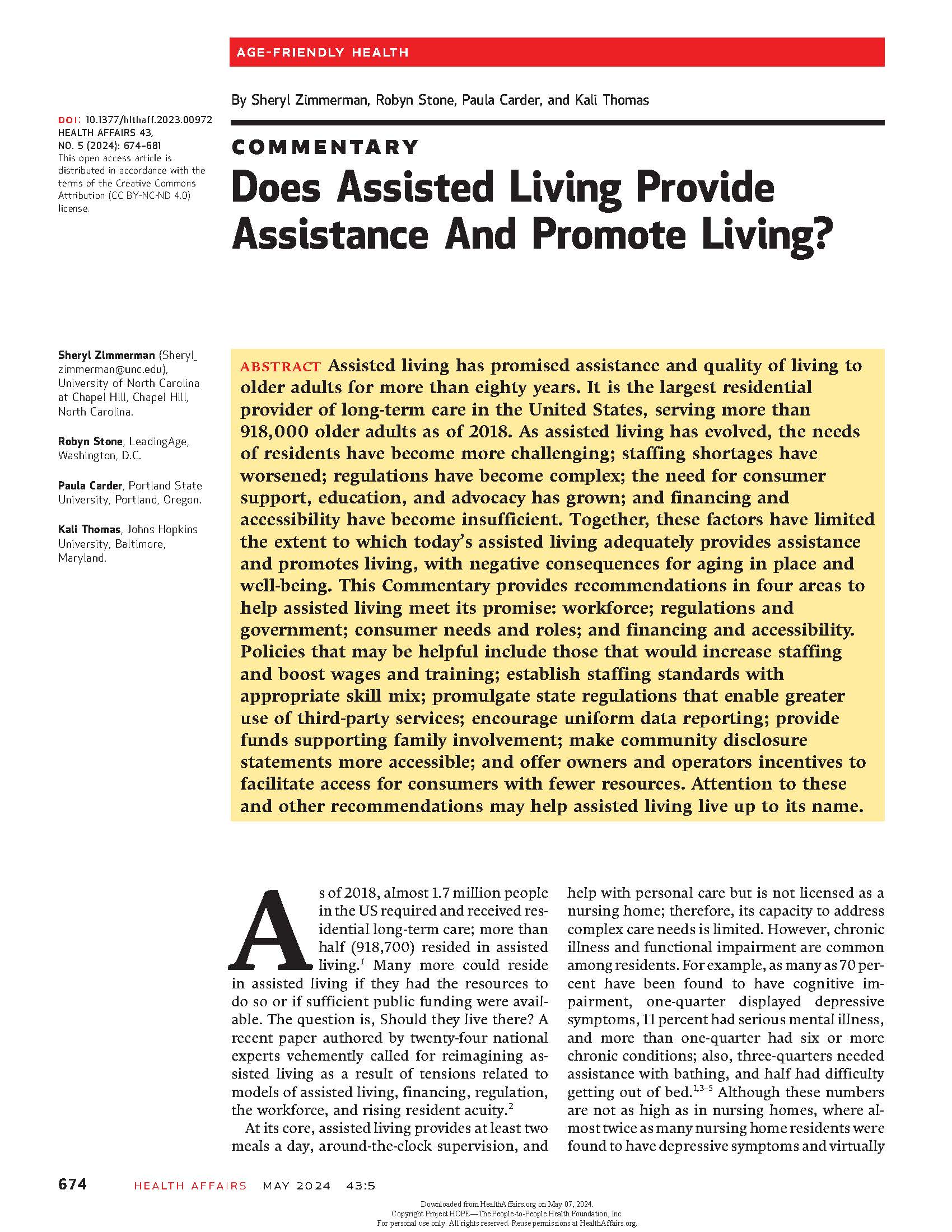Purpose: The older adult population continues to increase, resulting in greater use of health care resources. Nurses will be at the forefront of providing competent care to this population, but many nurses do not wish to work with the aged population after graduation. The current study sought to explore whether the addition of a clinical […]
Staff/Staffing
A Collaborative Approach to Improving Care Outcomes for Residents in Assisted Living
A Collaborative Approach to Improving Care Outcomes for Residents in Assisted Living
Purpose: Assisted Living (AL) residents are embedded in “care convoys” comprised of a dynamic network of formal and informal care partners. Using the convoys of care model—a multi-level framework connecting care convoy properties to resident outcomes—we examined healthcare management and communication between convoy members. We recommend strategies to engage primary care in supporting collaboration, communication, […]
Practitioner Burnout and Productivity Levels in Skilled Nursing and Assisted Living Facilities, Part 1: A Descriptive Quantitative Account
Practitioner Burnout and Productivity Levels in Skilled Nursing and Assisted Living Facilities, Part 1: A Descriptive Quantitative Account
Importance: Understanding burnout among practitioners in skilled nursing facilities (SNFs) and assisted living facilities (ALFs) while considering contextual factors may lead to practices that enhance therapist and patient satisfaction as well as quality of care. Objective: To examine productivity standards and burnout in the context of setting and role, as reported by therapy practitioners in […]
From 65 to 103, Older Adults Experience Virtual Reality Differently Depending on Their Age: Evidence from a Large-Scale Field Study in Nursing Homes and Assisted Living Facilities
From 65 to 103, Older Adults Experience Virtual Reality Differently Depending on Their Age: Evidence from a Large-Scale Field Study in Nursing Homes and Assisted Living Facilities
WHAT THIS MEANS FOR YOU: Two related studies examined the experiences of 245 assisted living and nursing homes residents across 10 US states who used virtual reality (VR), as well as 39 caregiving staff who facilitated the VR experiences. Older residents enjoyed VR less, a result that was less strong when asked about other technologies such as phones and voice assistants. Staff who facilitated the experiences saw VR as generally enjoyable compared to other work activities and felt it improved their relationships with residents.
Attachment Behaviours in Adults with Intellectual Disabilities in Assisted Living Facilities: Representations from Direct-Care Staff
Attachment Behaviours in Adults with Intellectual Disabilities in Assisted Living Facilities: Representations from Direct-Care Staff
WHAT THIS MEANS FOR YOU: In this study, 19 support staff from 7 assisted living communities in Belgium were interviewed to understand about how adults with intellectual disabilities related to these staff. Themes revealed that staff often struggled finding a balance between supporting select attachment behaviors and maintaining a professional distance from residents to prevent negative impact on their work.
End-of-Life Care Transitions in Assisted Living: Associations With State Staffing and Training Regulations
End-of-Life Care Transitions in Assisted Living: Associations With State Staffing and Training Regulations
WHAT THIS MEANS FOR YOU: This study examined associations between end-of-life care transitions (meaning stays in hospitals and nursing homes in either the 7 or 30 days before death in this study) and state staffing and training requirements for nearly 114,000 Medicare beneficiaries who died in an assisted living community in 2018-2019. A higher proportion of transitions was associated with stricter regulations about licensed and direct care worker staffing, whereas a lower proportion was associated with more specific regulations about direct care worker training. Therefore, policymakers and practitioners may want to implement regulations that make staff training requirements more specific to better address end-of-life care.
Well-being of professional older adults’ caregivers in Alberta’s assisted living and long-term care facilities: a cross-sectional study
Well-being of professional older adults’ caregivers in Alberta’s assisted living and long-term care facilities: a cross-sectional study
WHAT THIS MEANS FOR YOU: A study in AL and other long-term care communities in Alberta assessed nurses’ and professional care aides’ physical, mental, and emotional health, behavior, stress, quality of life, turnover, and absenteeism. Mental and emotional health, quality of life, and stress related to turnover and absenteeism. Although 68% of caregivers reported being satisfied with their general health, they experienced heavy workloads and high stress. These issues may result in decreased job satisfaction, absenteeism, and higher turnover.
Patient Safety Culture in Assisted Living: Staff Perceptions and Association with State Regulations
Patient Safety Culture in Assisted Living: Staff Perceptions and Association with State Regulations
WHAT THIS MEANS FOR YOU: A total of 714 administrators and direct care workers in 257 assisted living communities reported that direct care workers had a more negative perception of patient safety culture (PSC) than administrators. Stricter state regulations, particularly regarding staffing, were associated with better perceptions of PSC among direct care workers.
“You Gotta Have Your Cry”: Administrator and Direct Care Worker Experiences of Death in Assisted Living
“You Gotta Have Your Cry”: Administrator and Direct Care Worker Experiences of Death in Assisted Living
WHAT THIS MEANS FOR YOU: Qualitative data from 27 administrators and 38 direct care workers in 7 assisted living communities found that when residents died, staff members balanced their personal feelings about death and their work role in a process called “managing the normalization of death” with varying levels of perceived success. Additional resources and training about managing resident death, including improved collaboration with hospice services and clearer end-of-life care policies, might be helpful for staff.
Staff Attitudes Related to Antipsychotic Prescribing in Assisted Living
Staff Attitudes Related to Antipsychotic Prescribing in Assisted Living
WHAT THIS MEANS FOR YOU: Data from over 13,500 residents from 247 assisted living communities indicated that healthcare supervisors who were more supportive of using medication to treat behaviors were more likely to have higher rates of antipsychotic prescribing in their communities. Health care supervisor attitudes may be leveraged to reduce antipsychotic prescribing.
Pilot Testing of the Promoting Positive Care Interactions Intervention in Assisted Living
Pilot Testing of the Promoting Positive Care Interactions Intervention in Assisted Living
WHAT THIS MEANS FOR YOU: Promoting Positive Care Interactions, a staff training program to establish positive care interactions with residents, was tested with 17 care staff in the memory care unit of one assisted living community. Although there were no significant changes in staff outcomes, participants’ perception of the community’s environment and policies improved, and staff showed good engagement throughout the study.
Administrator Turnover in Oregon Assisted Living and Residential Care Communities, March 2020–February 2021
Administrator Turnover in Oregon Assisted Living and Residential Care Communities, March 2020–February 2021
WHAT THIS MEANS FOR YOU: This study analyzed staffing records from 549 assisted living communities in Oregon and found approximately one-third of administrators left their jobs between March 2020 and February 2021. Nonprofit communities and those with more beds had less administrator turnover; administrators who had been in their roles for a longer time before the pandemic were less likely to leave their jobs. Offering memory care services, accepting Medicaid, rurality, and number of assisted living communities in the county did not relate to administrator turnover.
Factors Associated with the Quality of Staff-Resident Interactions in Assisted Living
Factors Associated with the Quality of Staff-Resident Interactions in Assisted Living
WHAT THIS MEANS FOR YOU: Using data from 379 residents from 59 assisted living communities, residents who were more frequently agitated tended to have worse care interactions with staff, while being in a for-profit community was associated with more positive interactions. Staff training in how to minimize resident agitation may improve the positivity of care interactions.
“We Weathered the Storm”: A Qualitative Phenomenological Study of the Lived Experience of Assisted Living Administrators during the COVID-19 Pandemic
“We Weathered the Storm”: A Qualitative Phenomenological Study of the Lived Experience of Assisted Living Administrators during the COVID-19 Pandemic
WHAT THIS MEANS FOR YOU: A qualitative study interviewing five assisted living administrators about their experiences during the COVID-19 pandemic found frequent changes in the administrators’ experiences during the pandemic, including having limited resources and responding to rapid policy shifts.
Bridging the Transition to Assisted Living: A Framework for Faith Community Nursing
Bridging the Transition to Assisted Living: A Framework for Faith Community Nursing
WHAT THIS MEANS FOR YOU: Using an example of an 85-year-old resident, the article proposes a framework for faith community nursing, emphasizing observation, meaningful conversations, advocacy, and assertive communication to ease the move from independent to assisted living.
“What Keeps Me Awake at Night”: Assisted Living Administrator Responses to COVID-19
“What Keeps Me Awake at Night”: Assisted Living Administrator Responses to COVID-19
WHAT THIS MEANS FOR YOU: This study assessed how the early COVID-19 pandemic (Feb-Aug 2020) affected 40 assisted living administrators in Oregon. Three resulting themes from the interviews were emotion and burnout management (e.g., monitoring staff reactions), information management (e.g., monitoring latest recommendations and safety protocols), and crisis management (e.g., decision-making, emergency planning).
Staff Reports of Behavioral Expressions of Persons with Dementia in 250 Assisted Living Communities
Staff Reports of Behavioral Expressions of Persons with Dementia in 250 Assisted Living Communities
WHAT THIS MEANS FOR YOU: This study included health care supervisors from 250 assisted living communities in 7 states to understand how staff respond to behavioral expressions of residents with dementia. The most commonly reported expressions were combativeness and anxiety. A thematic analysis found that in about 25% of cases, staff recognized the events preceding behavioral expressions (antecedents). Staff in smaller and memory-care only communities were more adept at identifying antecedents; additional training to anticipate expressions may help prevent them.
Potential Side Effects and Adverse Events of Antipsychotic Use for Residents With Dementia in Assisted Living: Implications for Prescribers, Staff, and Families
Potential Side Effects and Adverse Events of Antipsychotic Use for Residents With Dementia in Assisted Living: Implications for Prescribers, Staff, and Families
WHAT THIS MEANS FOR YOU: This study examined the use of antipsychotic medications among residents with dementia in 91 AL communities across seven states. The prevalence of potential side effects was high (93%) and of possible adverse events low, (6%), potentially associated with medication side effects. Quetiapine (Seroquel) and risperidone (Risperdal) were the most frequently prescribed antipsychotics. Most, but not all, residents’ family members were aware of their relative’s antipsychotic use.
Assisted Living Administrators’ Approaches to Advance Care Planning
Assisted Living Administrators’ Approaches to Advance Care Planning
WHAT THIS MEANS FOR YOU: Interviews with 27 AL administrators revealed different approaches to advanced care planning (ACP). They all acknowledged the importance of ACP and often discussed topics like “do-not-resuscitate” orders when new residents arrived. Challenges included insufficient ACP training for staff and administrators and some reluctance from residents and families to discuss ACP. Most communities lacked a systematic, structured ACP approach.
The Impact of Cognitive Impairment on Clinical Symptoms, Physical Activity and Care Interactions among Residents in Assisted Living Settings
The Impact of Cognitive Impairment on Clinical Symptoms, Physical Activity and Care Interactions among Residents in Assisted Living Settings
WHAT THIS MEANS FOR YOU: This study included 550 AL residents from 59 communities, and assessed how cognitive impairment relates to physical activity, pain, and willingness to receive staff-assisted function-focused care. It found that cognitively impaired residents were less active, experienced more pain, and were less interested in staff-assisted function-focused care activities.


